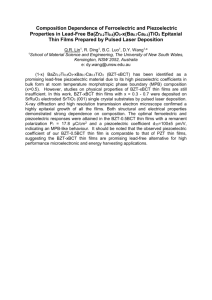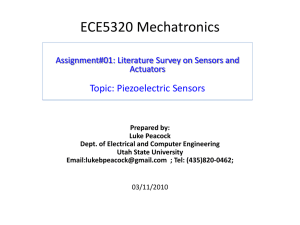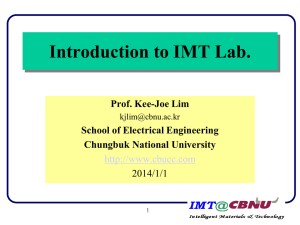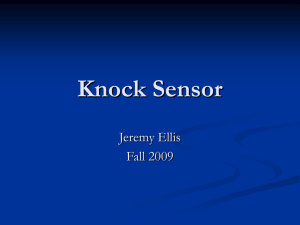Itenberg_Piezoelectrics_USB_handheld_HW4
advertisement
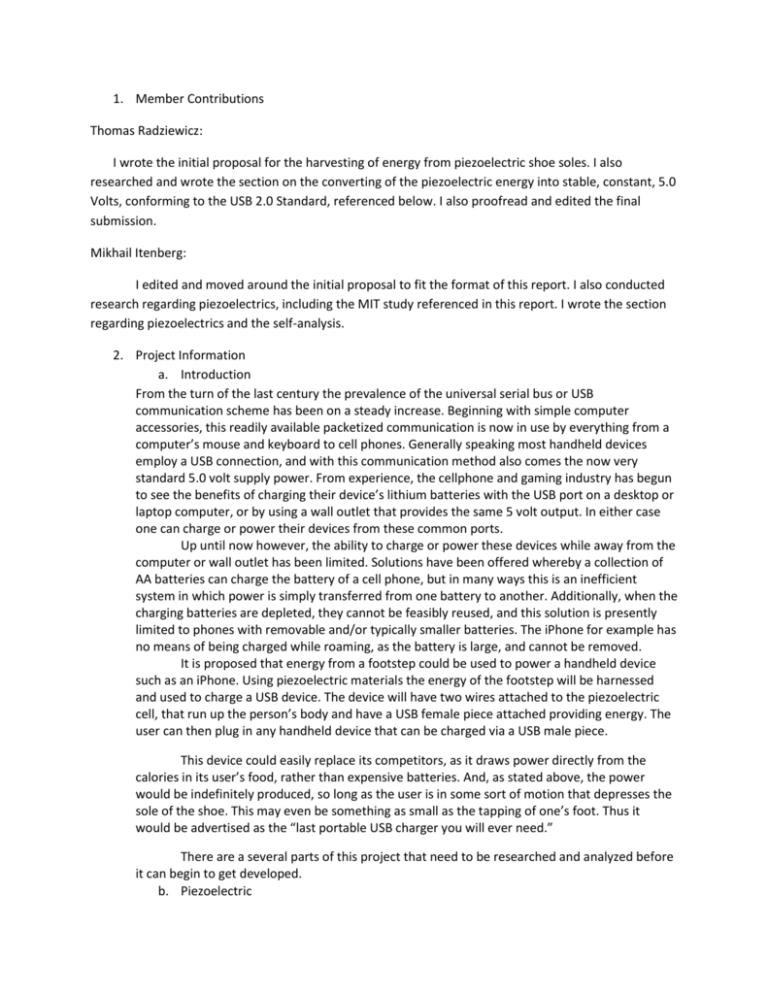
1. Member Contributions Thomas Radziewicz: I wrote the initial proposal for the harvesting of energy from piezoelectric shoe soles. I also researched and wrote the section on the converting of the piezoelectric energy into stable, constant, 5.0 Volts, conforming to the USB 2.0 Standard, referenced below. I also proofread and edited the final submission. Mikhail Itenberg: I edited and moved around the initial proposal to fit the format of this report. I also conducted research regarding piezoelectrics, including the MIT study referenced in this report. I wrote the section regarding piezoelectrics and the self-analysis. 2. Project Information a. Introduction From the turn of the last century the prevalence of the universal serial bus or USB communication scheme has been on a steady increase. Beginning with simple computer accessories, this readily available packetized communication is now in use by everything from a computer’s mouse and keyboard to cell phones. Generally speaking most handheld devices employ a USB connection, and with this communication method also comes the now very standard 5.0 volt supply power. From experience, the cellphone and gaming industry has begun to see the benefits of charging their device’s lithium batteries with the USB port on a desktop or laptop computer, or by using a wall outlet that provides the same 5 volt output. In either case one can charge or power their devices from these common ports. Up until now however, the ability to charge or power these devices while away from the computer or wall outlet has been limited. Solutions have been offered whereby a collection of AA batteries can charge the battery of a cell phone, but in many ways this is an inefficient system in which power is simply transferred from one battery to another. Additionally, when the charging batteries are depleted, they cannot be feasibly reused, and this solution is presently limited to phones with removable and/or typically smaller batteries. The iPhone for example has no means of being charged while roaming, as the battery is large, and cannot be removed. It is proposed that energy from a footstep could be used to power a handheld device such as an iPhone. Using piezoelectric materials the energy of the footstep will be harnessed and used to charge a USB device. The device will have two wires attached to the piezoelectric cell, that run up the person’s body and have a USB female piece attached providing energy. The user can then plug in any handheld device that can be charged via a USB male piece. This device could easily replace its competitors, as it draws power directly from the calories in its user’s food, rather than expensive batteries. And, as stated above, the power would be indefinitely produced, so long as the user is in some sort of motion that depresses the sole of the shoe. This may even be something as small as the tapping of one’s foot. Thus it would be advertised as the “last portable USB charger you will ever need.” There are a several parts of this project that need to be researched and analyzed before it can begin to get developed. b. Piezoelectric Harnessing energy from a footsteps via piezoelectric is not a new concept. MIT researchers have been studying this concept and have had breakthroughs. In one study a shoe was able to send out a 12-bit wireless identification code, which is useful in a variety of applications. [1] However, for the purpose of charging a USB device not enough energy was supplied to this device. One of the challenges of this project will be to design a piezoelectric device that will produce enough energy to charge a USB device based on USB specifications listed in section D. i. Review of Piezoelectric Many materials exhibit a property where the introduction of stress results in an electric potential difference. This is called the piezoelectric effect. Certain ceramics exhibit the piezoelectric effect. A necessary characteristic of piezoelectric ceramics is that they are formed as a single crystal. A random orientation of molecules cancels out the effect. [3] The amount of energy harnessed from a piezoelectric material depends on several factors, such as the molecular structure and geometry of the material, the piezoelectric properties, and the geometry of the forces applied. Piezoelectric materials are different from other ceramics because their dielectric constant decreases with an applied mechanical load and Young’s Modulus, the stiffness of a material, changes with an applied voltage. The change in the dielectric constant is of interest. The plates of a normal capacitor become charged with the application of voltage, however with a piezoelectric capacitor the plates become charged when stress is applied. Due to the decrease in the dielectric constant the power is released when a mechanical stress is present. One necessary property of piezoelectric is that the material must be formed as a single crystal. This poses a problem as ceramics have a multi-crystalline structure. The impurities of the grains cancel out the piezoelectric effect. In order to align the grains a process called poling takes place. During poling the material is introduced to a DC voltage which aligns the grains of the materials. Not all grains align; the amount of grains that align depends on aspects such as voltage, temperature and time. During poling the material changes shape due to the applied voltage, it increases in size between the electrodes and decreases in parallel. The poles during poling determine the poles of the piezoelectric once a force is applied. The geometry of the poling and the stress is worth researching for this project in order to maximize the energy harnessed from the footstep ii. Benders It is important to note that when piezoelectric materials are conducting electricity they are also changing shape. This is what makes it possible to create Piezoelectric Benders. To maximize the power produced from the piezoelectric materials; two piezoelectric materials are stacked on top of one another, with the negative poll touching. This means that when a force is applied to a piezoelectric and electricity is produced, one layer will be getting longer and thinner while the other layer is getting shorter and thicker. This creates a bending moment. In more advanced systems more than 2 layers of material are attached to produce even more power. iii. Manufactured Piezoelectric There are numerous kits online about Piezoelectrics that could be used to conduct test. The site where they are found is shown below http://www.piezo.com/prodeh0nav.html c. Power Supply Filtering The generation of power through the deformation of a piezoelectric material presents many challenges, and these challenges become increasingly difficult as the frequency of generation decreases. A study performed by MIT has shown that the heel of the shoe offers the best source of piezoelectric generation, as the quick impact of the heel during the beginning of a new step offers more energy than the slow curving of the sole. The study also outlines graphically the type of power developed by an average weight person walking at a slightly brisk pace (1 step per second). From the results of the MIT experiment it was shown that the “heel strike” offers greater than 5 times the power produced by the sole of the shoe. While the power generated by was small, other experiments have sought ways of reconfiguring the design to allow for increased usable production from the same stepping force. Experiments performed at Virginia Tech showed that by using smaller piezoelectric crystals arranged in parallel the time required to charge equivalently sized batteries decreased dramatically. “To demonstrate the power harvesting advantage, 40 and 80 mAhr Nickel Metal Hydride batteries are charged with each individual actuator then charged with both actuators connected in parallel. For a 1.4 Hz frequency (a brisk walking pace), the parallel combination charges two 40 mAhr batteries in 3.09 hours, and two 80 mAhr batteries in 5.64 hours. The individual actuators require 16.1 hours to charge a 40 mAhr battery, and 22.7 hours to charge an 80 mAhr battery.” This experiment did not use a real shoe, as with the MIT counterpart, but instead developed a consistent, easily repeatable, mechanical model. While the results of this model may not be seen quite as dramatically in the shoe itself it is reasonable to assume that by using paralleled piezoelectric crystals more usable energy can be derived from a step, and that the addition of further paralleled crystals would yield further decreased battery charging times. As this is the purpose of the project in question (to provide USB charging power), it stands to reason that a grid design using many paralleled piezoelectric materials would be the most efficient route of deriving useful energy from the human step. Assuming that more energy can be generated than the initial experiments the next obstacle is to rectify, filter, and possibly store the energy being developed so that a USB device can utilize it. As per the USB 2.0 standard found at USB.org one USB port must be capable of supplying 500 milli-Amps at precisely 5 Volts. From the MIT experiments it was seen that voltages up to 200 volts were produced with a 500 kilo-Ohm load. Additionally the bipolar production of the piezoelectric system must be considered as the current produced is not direct. As the heel first strikes occurs deformation of the crystalline material produces a voltage across the material which will always be in the same direction relative to the circuit (assuming the type of step is consistent). However, as the “heel strike” completes, the material returns to its original shape and dimensions, and generates a voltage opposite, and greatly less than the initial. This phenomenon is found in the original MIT experiment and can be seen on the next page. The voltage spike at approximately 0.9 seconds represents the heel first striking the surface below the shoe. The next spike is the rolling of the heel, and the return of the material to its original shape. The MIT researchers chose to view this information as the absolute value of the voltage, but from the perspective of power generation it is also useful to view the bipolar voltage production. It should also be noted that the while the initial spike is of greater amplitude, the area under underneath the initial and secondary generations is approximately equal. To first convert the generated voltage into pulsating DC a diode rectifier would be used. In this type of application a full wave rectifier would be employed. The exact specifications of the rectifier would be based on the voltages produced by the piezoelectric source, as the breakdown reverse biased voltage of the diode would have to be greater than the maximum possible voltage generated by either the “heel strike” or the resulting reformation of the crystal. With the voltage successfully converted to a pulsating DC, a system would be required to convert this into 5 volts at continuous current (.5A to conform to the USB 2.0 Standard). From other experiments in the piezoelectric field, one could surmise that filtering in some form is a necessity to providing device safe, usable power. To accomplish this task, and also to create a more user friendly device the following full bridge rectifier could be devised. In this system the voltage source would be the piezoelectric system attached to the heel of the shoe, the sole, or both. As power flows through the rectifier it is converted to pulsating DC about 1.4 volts lower than the input voltage (forward bias voltage of diodes). This high voltage pulsating DC would next pass through a resistor/capacitor filter, to help reduce the peak voltage spike. The output of the capacitor would ideally be held at or below 30V, and this would be accomplished by adjusting the size of the capacitor, the load at Vo, and the resistance value of the resistor coming from the full bridge. A 30V Zener diode could be implemented as shown to further ensure this safety margin. The capacitor itself may be the biggest limiting factor in the success of the project as the physical size of the capacitor needs to be considered. Assuming that the correct components could be integrated into a reasonably sized package, the output Vo would next be connected to an inline voltage regulator, such as the readily available 7805 5 volt regulator, intended for use in USB applications. This regulator would generate 5V at up to 1 amp (exceeding the requirement), from power inputs of 0-35 Volts. Such a regulator is commonplace, and offers an IC alternative to discrete power regulation components. The regulator would ideally be located outside of the clothing or shoes of the wearer, as there exists the potential of heat generation in the conversion. The voltage regulator would next be connected to a USB female port, for use by any USB 2.0 powered devices. The power output of the regulator will remain at 5V so long as the power required by the device is less than the power entering the regulator (with losses). 3. References “Energy Scavenging with Shoe-Mounted Piezoelectrics” – MIT Research found via IEEE Explore “Parasitic power harvesting in shoes” – MIT Research found via IEEE Explore http://www.eetimes.com/electronics-news/4197064/Piezoelectric-Technology-A-Primer http://www.piezo.com/ http://www.cimss.vt.edu/pdf/Conference%20Papers/Park/C20.pdf http://ece.uncc.edu/~smbobbio/ifa/ifa.html http://www.writing.eng.vt.edu/urs/simmers1.pdf http://homepage.ntu.edu.tw/~yichung/power_harvesting-jmm-2006.pdf http://www.usb.org/developers/docs/ http://www.radioshack.com/product/index.jsp?productId=2062599 4. Self Analysis Although the original project has proved unfeasible, there are many promising directions with which to proceed. The Piezoelectric effect is widely researched and many applications can be applied in many major projects. The military is one application in which the use of piezoelectric generation or sensing can prove very useful. Rescue mission may be made easier by homing signals generated from piezoelectric sources, and the cost and potential of these products will change greatly as further research is conducted. In order to maximize the energy harnessed it is worth researching optimizing power output through the geometry of piezoelectric materials, and testing with higher frequency footsteps (people jogging). Placing piezoelectric materials under dance floors has also been shown to produce a substantial amount of power. Research could be done into harnessing energy from floors of other constantly traversed surfaces (ie sidewalks, hallways of buildings).



